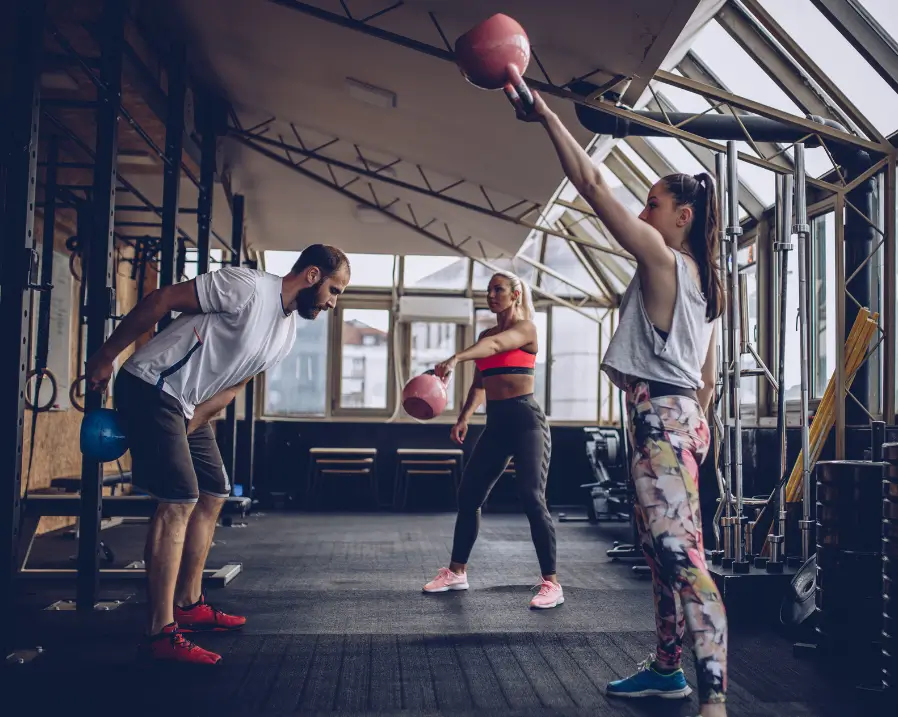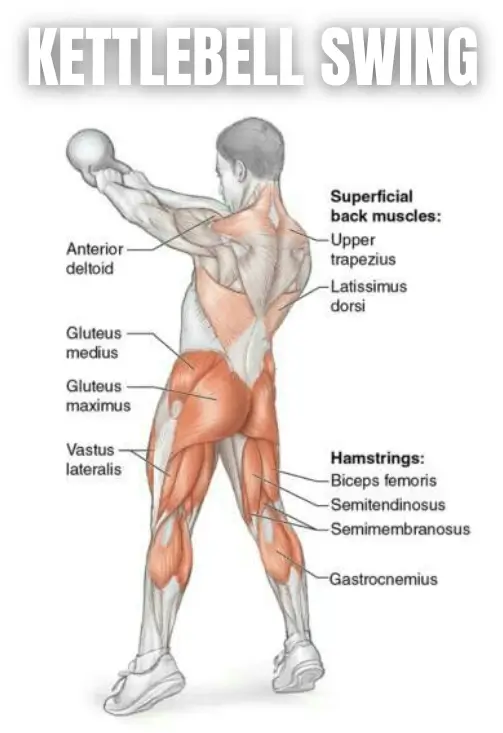Other posts
Have you ever seen someone swinging a cannonball with a handle and wondered what the fuss was about? That’s kettlebell training – and it’s here to reshape how you move, train, and feel.
Once a tool used by Russian military forces and old-school strongmen, kettlebells have exploded in popularity in gyms, CrossFit boxes, and home workouts globally. And for good reason. These compact weights pack a punch: blending strength, cardio, and functional movement into one powerful workout.
In this guide, we’ll break down how to use kettlebells the smart way—whether you’re a beginner or ready to level up. You’ll learn the top kettlebell exercises, discover the benefits of kettlebell workouts, and see how to build a balanced kettlebell routine that fits your goals.
At GymFactory, we believe in training smarter, not longer—and kettlebells are one of the best tools. Ready to feel stronger, leaner, and more capable with just one piece of equipment? Let’s swing into it.

Kettlebells aren’t just a gym trend – they’re a game-changer for full-body fitness. Whether your goal is to build strength, improve cardio, or move better daily, kettlebells are one of the most efficient tools you can add to your training. At GymFactory, we recommend kettlebells because they deliver results—fast, smart, and without needing a full rack of equipment.

1. Full-Body Conditioning
Kettlebell movements like swings cleans, and presses engage multiple muscle groups in a single move. You’re not just isolating one area—you’re training your body as a connected system. This leads to better coordination, strength, and muscular endurance. A single full-body kettlebell workout can hit your glutes, core, shoulders, and grip strength in just a few sets.
2. Improved Grip & Core Strength
Kettlebells challenge your grip and core in every movement due to their offset center of gravity. Even holding a kettlebell demands more from your stabilizing muscles than a dumbbell would. Over time, this builds stronger hands, wrists, and a more resilient core—great for athletes, lifters, and anyone wanting to boost their functional strength.
3. Cardio and Strength in One
Why choose between cardio and lifting when you can have both? Kettlebell training delivers a metabolic combo—your heart rate climbs like a HIIT workout, while your muscles are pushed through resistance-based movement. This makes kettlebell sessions a time-saving, fat-burning powerhouse.
4. Functional Fitness & Mobility
Kettlebell training supports functional fitness—movements that mimic real-life activities like lifting, twisting, and reaching. Exercises such as the Turkish get-up or goblet squat help improve joint health, balance, and coordination. Plus, the dynamic nature of kettlebell work increases mobility and control through a full range of motion.
5. Time Efficiency
Kettlebell workouts are short, intense, and effective. Most routines can be done in 20–30 minutes, hitting strength and conditioning. That’s why kettlebells are a favorite at GymFactory—you don’t need to spend hours in the gym to see results.
6. Fat Loss + Muscle Building
Kettlebells aren’t just for getting stronger—they’re incredibly effective for fat loss too. Their unique combination of dynamic, compound movements boosts your heart rate while building lean muscle. This means you burn more calories during your workout and continue to burn fat long after it’s over. Kettlebell strength training has been shown to improve body composition and metabolic function, making it a powerful option for anyone chasing lean gains.
7. Different from Dumbbells and Barbells
What makes kettlebells special? Their shape. The handle and off-center weight distribution force your body to stabilize more than traditional weights. That means more muscle activation, better coordination, and a more athletic way to train. Plus, you can swing, press, flow, and carry—all without changing equipment.
Ready to swing into action? Whether you’re brand new or just looking to clean up your form, getting started with kettlebells doesn’t have to be complicated. The key is to start smart, focus on technique, and build a solid foundation before diving into more advanced moves.
Choosing the Right Kettlebell Weight
Start too heavy, and your form suffers. Start too light, and you won’t get much out of the workout. For most beginners, a good starting point is 8–12 kg (18–26 lbs) for women and 12–16 kg (26–35 lbs) for men. If unsure, always choose the lighter option and focus on form. You can progress as your strength improves.
Mastering Proper Form and Safety
Kettlebell training is safe if you learn the basics first. Poor form can lead to injuries, especially with dynamic moves like swings or snatches. Keep your spine neutral, engage your core, and hinge at the hips—not the lower back. If possible, work with a certified trainer to check your technique.
Don’t Skip the Warm-Up
Because kettlebell movements are explosive and demand full-body engagement, warming up is crucial. Focus on dynamic stretches and mobility drills that prepare your hips, shoulders, and core. A good warm-up sets the tone, reduces injury risk, and makes your session more effective.
Follow a Trusted Beginner Plan
Instead of jumping into random YouTube workouts, follow a structured beginner program. This ensures balanced progression, proper technique, and better results.
At GymFactory, we recommend starting with just 2–3 basic movements and gradually increasing complexity as your confidence grows. If you’re unsure where to start, check out this trusted beginner kettlebell workout plan.
Whether you’re training at home or in the gym, kettlebells offer endless ways to move. Here are seven powerful exercises that cover the essentials—plus variations for beginners and more advanced lifters.
The kettlebell swing is the foundation of most kettlebell training. It’s a hip-hinge movement that powers the bell forward using your glutes, hamstrings, and core—not your arms. This move improves power, burns fat, and builds serious endurance.
Muscles worked: Glutes, hamstrings, core, lower back
Pro Tip: Keep your arms relaxed—your hips do the work.
2. Goblet Squat
This front-loaded squat helps improve posture, balance, and lower-body strength. Holding the kettlebell at chest level forces your core to stay engaged and prevents you from leaning forward.
Muscles worked: Quads, glutes, core.
Pro Tip: Drive your elbows inside your knees at the bottom to open up your hips.

The Turkish get-up is a slow, controlled movement that builds full-body strength, coordination, and shoulder stability. You’ll move from lying to standing while holding the kettlebell overhead.
Muscles worked: Core, shoulders, glutes, stabilizers
Pro Tip: Focus on one step at a time. Don’t rush—this move is about control.
This powerful combo move builds strength, coordination, and cardio conditioning. You’ll clean the bell to your shoulder, then press it overhead in one fluid movement.
Muscles worked: Shoulders, upper back, arms, core.
Pro Tip: Keep the bell close to your body during the clean to avoid banging your forearm.
This pulling movement strengthens your back and arms while also improving posture. Supporting yourself with one hand on a bench or your knee, row the kettlebell with control.
Muscles worked: Lats, traps, biceps
Pro Tip: Don’t twist your torso—keep your core tight and your back flat.
This is a perfect beginner move that teaches proper hip hinge mechanics while targeting the posterior chain. It sets the foundation for more dynamic movements like swings and cleans.
Muscles worked: Hamstrings, glutes, lower back
Pro Tip: Keep your chest up and shoulders back throughout the lift.
7. Kettlebell Snatch (Advanced)
The kettlebell snatch is a fast, powerful movement that takes the bell from the ground to overhead in one explosive motion. It’s an advanced move that requires solid technique and timing.
Muscles worked: Full body—especially shoulders, core, hamstrings
Pro Tip: Master swings and cleans before attempting snatches.
Optional: Sample Workout
Want to put it all together? Try this:
Beginner Full-Body Kettlebell Routine:
Jumping into random workouts might get you sweaty—but it won’t guarantee results. The key to progress with kettlebells is having a structured plan that includes strength, mobility, and recovery. Whether you’re training three or five days a week, balance is everything.
Build Around Movement Patterns
Don’t just focus on muscle groups. Instead, build your kettlebell routine around movement patterns: push, pull, hinge, squat, carry, and rotate. This ensures your body moves well and stays injury-free. For example, you might combine kettlebell swings (hinge), goblet squats (squat), and rows (pull) in one workout.
Plan Your Training Days
Here’s a simple way to structure your week:
3-Day Routine (Beginner)

5-Day Routine (Intermediate/Advanced)
This format blends kettlebell strength training with cardio and mobility work for sustainable progress.
Don’t Forget Recovery
Training hard is important—but recovery is where the growth happens. Include at least one day per week for mobility work, walking, foam rolling, or yoga. This keeps your joints healthy and prevents burnout.
Adjust Based on Your Goals
Want to build strength? Keep reps low and focus on heavy lifts. Are you looking to burn fat? Try kettlebell circuits with minimal rest. Your routine should reflect your personal goals, schedule, and experience level.
Kettlebells are powerful—but only if you use them right. Many beginners make the same few mistakes that can stall progress or lead to injury. Here’s what to watch out for (and how to fix it).
1. Using the Wrong Weight
Too heavy, and your form breaks, too light, and the workout isn’t effective. Choosing the right kettlebell size is essential for safe and efficient training. Start with a moderate weight you can control—especially during swings and overhead movements.
2. Skipping the Warm-Up
Jumping straight into swings or snatches without warming up is a recipe for tight hips, sore shoulders, or worse. A proper warm-up prepares your body, activates your core, and increases your range of motion.
3. Rushing the Form
Speed should never come before control. If you’re flying through reps with sloppy form, you’re not only losing results—you’re risking injury. Focus on moving well before moving fast. It’s better to perform 5 clean swings than 20 rushed ones.
4. Holding Your Breath
Breathing might seem automatic—but during kettlebell lifts, it’s a skill. You should exhale on the effort (like at the top of a swing or press) and inhale on the recovery. This keeps your core braced and your movements controlled.
5. Ignoring Recovery Days
Rest isn’t weakness—it’s where strength is built. Overtraining can lead to fatigue, injury, and burnout. Schedule at least one or two recovery days per week, and use them for mobility work or light movement to stay fresh.
One of the best things about kettlebell training? It meets you where you are. Whether you’re a complete beginner, a weekend warrior, or a seasoned lifter, kettlebells can be adapted to match your current level—and help you level up.
For Beginners
New to training? Start with simple, low-impact movements like deadlifts, goblet squats, and swings. Focus on mastering form before adding speed or weight. Many beginners love kettlebells because they’re accessible, space-saving, and easy to learn at home or in the gym.
For Strength Athletes
Kettlebells are excellent for building explosive power, grip strength, and stability—perfect complements to barbell lifts. Movements like the kettlebell clean & press and snatch challenge strength and coordination, while supporting injury prevention and functional carryover.
For HIIT & Conditioning Lovers
Looking to burn fat and get sweaty fast? Kettlebells shine in high-intensity intervals. Combine swings, squats, and presses in fast-paced circuits for a HIIT-style kettlebell workout that torches calories while building lean muscle.
For Rehab & Low-Impact Training
Kettlebells are also ideal for rehab, mobility, and low-impact training. Exercises like carries, windmills, and get-ups improve joint health, stability, and movement control—without loading your body aggressively.
Kettlebells aren’t just another fitness trend—they’re a long-term training tool that delivers serious results. Whether your goal is to get leaner, move better, or build functional strength, kettlebell training is one of the most efficient and effective ways.
The best part? You don’t need a gym membership or fancy setup to get started. A kettlebell and a few basic movements are enough to kick off your transformation.
At GymFactory, we’re here to support your journey from day one—with premium-quality kettlebells designed for performance, durability, and comfort.
Get your first kettlebell from GymFactory and start your training at home today.
Customer service
JOIN OUR NEWSLETTER